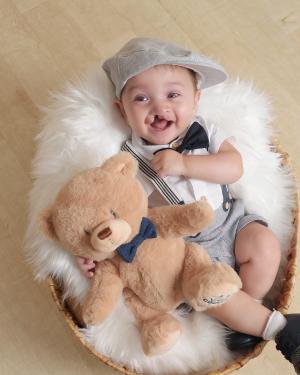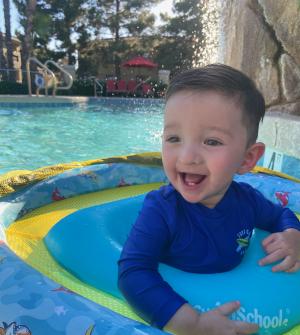
Two-year-old Dylan has kept his parents busy, and smiling, since day one. When he was born, he immediately had the whole room laughing as he stuck his booty straight in air while being weighed. Since then, he has continued to be a bundle of fun energy. You would never believe that he’s already had two surgeries, one for a cleft lip and one for a cleft palate.
Diagnosis and feelings of guilt
Dylan’s parents found out that he might have a cleft lip and palate before he was born, during a routine ultrasound. The news came as a shock.
“My wife immediately started crying,” remembered Dylan’s dad, Arthur. “She felt guilty, like she was at fault.”
Dylan was born with a cleft of both his lip and palate. About one in 800 kids born in the U.S. have a cleft lip and/or palate. Most of the time, the cause is unknown.
“The term we use is multi-factorial,” explained Tom Sitzman, MD, Dylan’s plastic surgeon. “There are sometimes drugs and chemicals that can cause a cleft lip or palate during pregnancy, and there are families with a genetic risk of cleft lip or palate, but Dylan’s mom had none of those things. In about 70% of the cases, it just happens.”
Early feeding challenges were met with support
One challenge Dylan’s parents noticed right away was his inability to breastfeed or take a bottle. With a cleft lip and palate, the lip doesn’t form completely. There’s also a separation in the roof of the mouth. Arthur remembers being able to see inside Dylan’s nose every time he opened his mouth.
“He wasn’t able to suck because of the palate being open,” he said. “Every time he would eat, he would choke because it would go down his breathing tube.”
Thankfully, Dylan’s family received support from the beginning. About a week after Dylan’s birth, his parents got a call from the Center for Cleft and Craniofacial Care at Phoenix Children’s.
“They told us that they had a doctor assigned to us and a team to look out for my son,” shared Arthur. “They would make sure that everything was good with him, and we would take him to appointments and care for him.”
The only treatment for a cleft lip and palate is surgery, so they scheduled his cleft lip surgery first.
“We do lip repair when kids are old and strong enough, which is usually about 4 months of age,” explained Dr. Sitzman. “For the palate repair, we like to wait until kids are a little bigger and stronger, which is around 9 months of age.”
Surgery preparation and teamwork
To prepare for surgery, Dylan’s parents worked with their care team at Phoenix Children’s. They both attended every visit together and appreciated the network of people involved in Dylan’s care. They had a feeding therapist, who spoke to them in Spanish and helped them learn how to feed Dylan at home. They also met with a social worker, who helped them talk through methods for coping – finding ways to deal with a new diagnosis, feelings of blame and loss of control.
“My wife felt so, so guilty,” said Arthur, “but they had a psychologist there to talk with her and help her get through that. They’re really good at what they do.”
Dylan’s family also met with an orthodontist at the Center for Cleft and Craniofacial Care. Most kids with a cleft lip and palate benefit from taping the lip before surgery. The orthodontist showed them how to use a special type of tape to pull the two sides of the lip closer together. They also used a plastic stent to improve the shape of Dylan’s nose.
“The goal is to take a very wide cleft and turn it into a narrow cleft prior to surgery,” said Dr. Sitzman. “It doesn’t always happen, but we offer it to every child, and about 80% of families do it. Many parents also seem to benefit from taking that active role in helping their child get better.”
“The cleft and craniofacial team guided us through the whole thing, and they were awesome,” said Arthur. “They showed us exactly what we needed to do. We saw them every two weeks, starting from when Dylan was born until the surgery. We could call them for advice at any time.”
After cleft lip and palate surgery
After Dylan completed his lip surgery, he stayed at the hospital overnight and then was sent home to recover, which usually takes about a week. A few months later, he successfully had his palate surgery.
The hardest part of recovery from Dylan’s palate surgery was keeping him away from solid foods. For the first 20 days after surgery, he was on a liquids-only diet, followed by 20 days of soft foods.
“He wanted [to eat] everything,” Arthur remembered. “That’s how he is now. One of his favorites is In-N-Out French fries, animal style. He can take down one of those by himself.”

Today, almost a year after completing both surgeries, Dylan’s parents say he’s growing so fast. His cleft lip and palate have not held him back.
“He’s up and running, after taking so much pain like it was nothing, like it was normal to him,” said Arthur.
Dr. Sitzman added, “We try to get every kid through their lip repair and palate repair by one year of age, and Dylan hit our goal. His weight gain was excellent along the way. He really thrived.”
Big smile, bright future
Because of Dylan’s cleft lip and palate, he’ll always be at risk for speech problems. At Phoenix Children’s, his feeding therapist will transition into offering speech therapy. They’ll follow him as his speech develops and provide treatment if needed. Dylan also will continue working with an orthodontist throughout his adolescence.
It’s possible that Dylan will benefit from a touch up surgery either before kindergarten or in his teenage years. Otherwise, Dylan is growing up and on the move. His parents are extremely grateful for Phoenix Children’s and how easy the entire process has been.
“This was something we never dreamed about encountering,” said Arthur. “Now, we have our son, and it’s just awesome. It’s been a blessing.”
